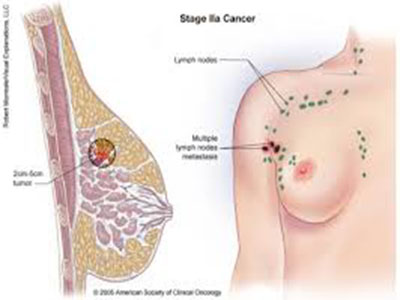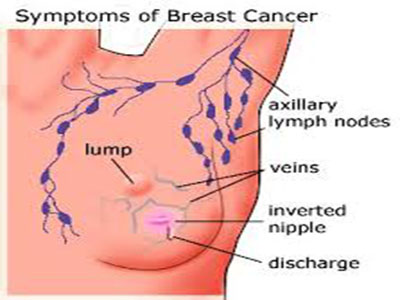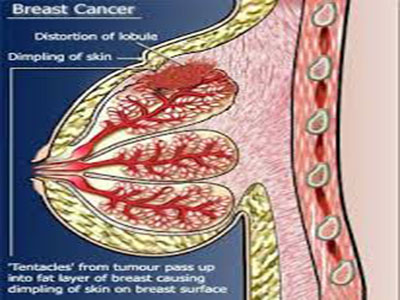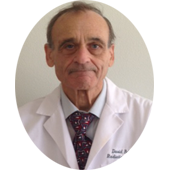





Breast Cancer
Types of Breast Cancer
Two types of cancer that occur rarely are inflammatory breast disease, in which cancerous cells block the lymph vessels within the breast, and Paget disease of the nipple, in which the cells in or around the nipple become cancerous. They account for, respectively, approximately one to six percent, and approximately one percent, of breast cancers. The two most common types of breast cancer are ductal carcinoma and lobular carcinoma. Ductal Carcinoma
This is the most prevalent type of breast cancer, and it begins in the cells that line the milk ducts. More than half of breast cancer cases diagnosed each year are of this type. There are two kinds of ductal carcinoma: Ductal carcinoma in situ (DCIS). With DCIS, cancer cells are found only in the milk-duct lining, and have not spread to other breast tissue. DCIS is often discovered when a mammogram is done as part of a regular screening. In recent years, the number of DCIS diagnoses has increased dramatically, primarily because the number of screening mammograms has increased. DCIS isn\'t life-threatening, but requires treatment to make sure the cancer does not spread.
Invasive ductal carcinoma (IDC)
Lobular carcinoma begins in the breast milk-producing glands, which are called lobules. The breast contains 15 to 20 lobes; the lobules are the smaller lobes within them. There are two types of lobular carcinoma: Lobular carcinoma in situ (LCIS) With LCIS, cancer cells are found only in the breast lobules, and do not spread to other tissue. LCIS is asymptomatic, and usually does not show up on mammograms. It is often discovered when a biopsy is performed for another reason. Invasive lobular carcinoma (ILC) With ILC, cancer cells spread from the lobules to close-by breast tissue. It requires treatment at an early stage to make sure it does not spread from the breast to other parts of the body. It accounts for approximately 10 to 15 percent of invasive-type breast cancer cases. Risk Factors for Breast Cancer The greatest risk factor for developing breast cancer is being female, probably because men produce much less estrogen and progesterone, hormones that can promote the growth of malignant breast cells. Other risk factors for women may include: Being 55 years of age or older Carrying a BRCA1 or BRCA2 gene mutation Having a family history of breast cancer Having been diagnosed with breast cancer before Having dense breast tissue Having certain benign breast conditions Using, or having used, hormone therapy Signs or Symptoms of Breast Cancer Women are advised to perform a breast self-exam once a month to check for changes or abnormalities, which may include: A lump in the armpit that does not go away after a menstrual cycle Swelling in the armpit Pain or tenderness in the breast A change in the size, contour, texture or temperature of the breast A change in the nipple An unusual discharge from the nipple A flattening or indentation in the breast Diagnosis of Breast Cancer Most testing for breast cancer begins when a woman or her doctor finds an abnormality in the breast through a physical exam, or when a routine mammogram picks up an abnormality. Tests that may be performed to diagnose breast cancer include:
- Diagnostic mammogram
- Ultrasound
- MRI scan
- Fine-needle-aspiration biopsy
- Core needle biopsy
- Surgical biopsy
- Ductogram
- Sentinel-node (lymph-node) biopsy
Our Vision...
- 1
- 2
- 3
 Dr. James I. Bicher, M.D.
Dr. James I. Bicher, M.D.
Hadassah Medical School, Jerusalem, Israel
Member of National Committee on Hyperthermia. A Founder and Past President of the North American Hyperthermia Group (NAHG). Secretary and (1972-1981) President (1981) of International Society of Oxygen Transport of Tissue. Zondec Award, (Hadassah Medical School, Jerusalem), 1962. President and Founder of the American Society of Clinical Hyperthermia (ASCHO).
 Dr. Ralph S. Wolfstein, M.D.
Dr. Ralph S. Wolfstein, M.D.
University of Michigan
Former, "Acting Director, Department of Radiation Therapy Nuclear Medicine: at Cedars - Sinai Medical Center. Member in Society of Nuclear Medine, Charter Member in American College of Nuclear Physicians. Member of American Society of Therapeutic Radiology and Oncology. Member of Radiation Research Society. Charter Member of International Clinical Hyperthermia Society.
 Dr. David Bell, M.D.
Dr. David Bell, M.D.
Tulane University School of Medicine, New Orleans
PhD in mathematics from, "Brown University".Community Hospital, Long Beach, CA - Medical Director of Radiation Oncologist. Board Certified, Society Member of, "PHI BETA KAPPA & SIGMA XI".
